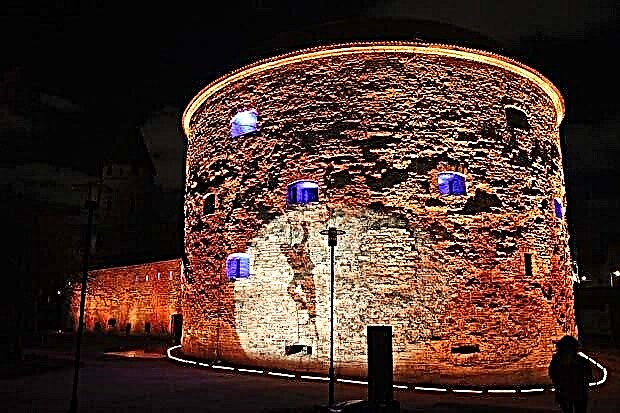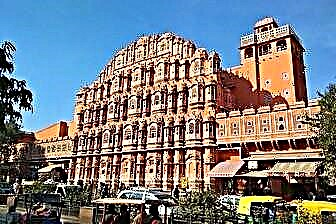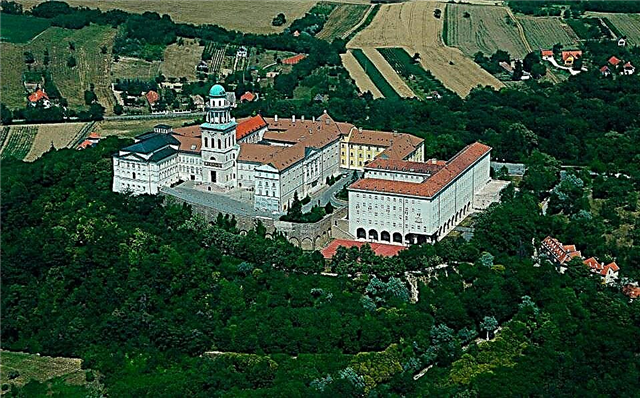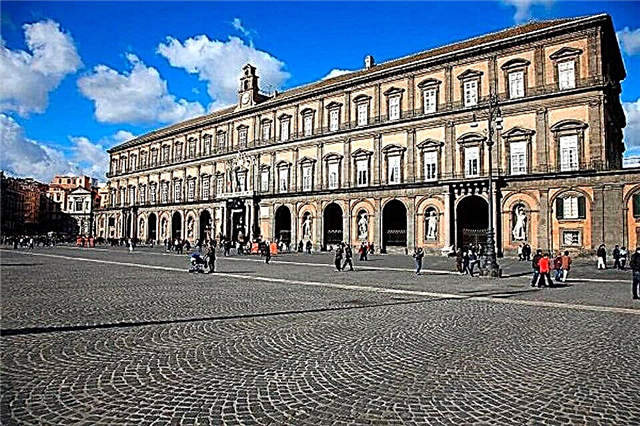Many of those who have just heard about the Italian city of Naples love the famous Neapolitan songs, expressive, temperamental, full of passionate sensuality and subtle lyricism. Such enchanting melodies can only be created by a people who are not afraid to live in the neighborhood of the formidable Vesuvius, every century reminding of its existence with dangerous eruptions. Neapolitan dances are just as expressive, temperamental and graceful as the Neapolitans themselves. From the moment the city was founded by the ancient Greeks (8th century BC), Naples became part of different empires and kingdoms, until the state of Italy was formed in 1860. Now it is the third largest Italian city with a population of one million, in the vicinity of which another 2 million people live. Let's talk about the main attractions of Naples.
Mount Vesuvius

It is one of the most formidable and powerful volcanoes in the world, spewing ash and lava around for thousands of years. Ironically, at its foot there are such paradisiacal places for life, with fertile soils, rich flora and fauna, that people, despite the mortal danger, have settled here since ancient times. Legendary Pompeii, Stabia and Herculaneum, scorched by hot lava and buried under an 8-meter layer of ash in 79 AD. e. - reliable confirmation of this.
Until now, excavations continue at the site of ancient cities, the finds of which amaze with the incredibly insane force of the most terrible eruption, when the contents of the crater were thrown out in a volume of 100 thousand tons per second to a height of 35 km. Hot magma poured in streams created a temperature of 500 degrees, instantly turning everything into ash. The humanity of the planet is still shaken by an unprecedentedly violent eruption, despite the past millennia.

Now the volcano is a place of pilgrimage for tourists (4 million a year), striving to get as close as possible to the mouth of the "fire-breathing dragon". They climb up a trail winding among volcanic ash, solidified lava and pumice (the funicular was destroyed by the 1979 earthquake). Adrenaline makes the extreme conquerors of the volcano walk in clouds of dust under the scorching sun, every now and then bumping into small stones. It is good that there are benches along the trail where you can relax and unwind. It does not delight many enthusiasts who have reached the crater with its lifeless gray walls and sparse vegetation, breaking through with rare bushes. But the feeling of self-satisfaction, admiration for the amazing views that open below, makes you forget about the difficulties of climbing.
Royal Palace

On the main magnificent square of Naples, the Plebiscite, there is a monumental three-story building with a large number of windows - the Royal Palace, built for half a century (1600-1650). It was intended for the Neapolitan rulers from the Bourbon family, therefore they built the palace on a grand scale inherent in this dynasty. The external appearance of the palace has survived to this day, corresponding to the rebuilding of the 18th century, which took place under the supervision of the famous court architect Vanvitelli, an expert on the late Baroque.

The semicircular arched vaults of the façade are adjacent to wall niches, each of which contains one statue of the most prominent rulers of the kingdom. The window frames are decorated with stucco patterns; a clock tower with a round clock is installed on the roof attic. On the rear side, the palace is surrounded by a garden, near the gates of which there are equestrian statues of the St. Petersburg Anichkov Bridge. The interiors are finished with pompous luxury, with many stucco ornaments, bas-reliefs and sculptures. Wide stone staircases with massive patterned railings, high arches, rich chandeliers, stucco ceilings, picturesque masterpieces of famous artists of the past create a majestic entourage of the palace halls.
Today the building of the Palace houses several different institutions. The largest part is occupied by the National Library, with a huge book fund, including priceless papyri from ancient Herculaneum buried under the ashes of Vesuvius. Several Halls of the palace (Central, Throne, Hall of Hercules) are combined into a museum of historical apartments. They house the greatest works of art by Titian, Giordano, Preti and other prominent Italian painters.
Pompeii is a tragic landmark

In the vicinity of Naples, there is the popular archaeological complex of Pompeii - an ancient city that, in a matter of minutes, found itself under an eight-meter layer of ash and other emissions from Mount Vesuvius during the eruption in 79 AD. How many prosaic and poetic lines are devoted to this catastrophe, which destroyed all living things around, how many artists displayed the cataclysm in their canvases! The famous painting by K. Bryullov "The Last Day of Pompeii" is an eloquent testimony to the tragedy of a universal scale, it amazes with its artistic expressiveness.
Over the centuries, on the site of the lost cities, new ones arose, the inhabitants of which did not even know about Pompeii until they reached the ruins during excavations. So the world learned about the unprecedented manifestations of Vesuvius, and the cities buried alive began to actively excavate (1748-1960). The first expedition led by Alcubierre believed that the found objects were the city of Stabia, but in the process of further excavations they established their belonging to Pompeii.

Since then, a gigantic work has been done to clear the city, as a result of which it was possible to find out the detailed details of the disaster that had occurred. In the 60s of the 19th century, the archaeologist Fiorelli determined by the outlines of the voids formed from the bodies of people and animals, in which poses she found their death, filling the voids with plaster. It was found that all living organisms instantly evaporated from the hot temperature.
Now in Pompeii, restoration work continues, and some objects will appear before visitors almost in their original form. The Temple of Apollo (8th century BC) is still in ruins, but much of its history is already known to researchers. Of the 28 columns, only two have survived, allowing you to get a complete picture of the majestic colonnade of the temple. Remains of frescoes depicting the Trojan War in the preserved inner niches testify to the high skill of the ancient painters. Interesting monuments of Pompeii are Thermes, the House of Venus in a shell, the Amphitheater, the House of the Faun and many other unique sights of the revived city.
Church of the Assumption of St. Mary (St. Januarius)

In the historic center of Naples, on the Via Duomo square, there is the main shrine of the city - the Temple of St. Januaria or whatever else it is now called the "Temple of the Assumption of St. Mary." At the beginning of our era ancient churches were located on the site of the temple, reminding of themselves by the remains of walls. In the 13th century, Charles I ordered the construction of a temple in honor of the patron saint of the city of Januaria (13th century). It was fully completed already in the 14th century. during the reign of Karl's grandson. The facade of the Catholic church was renovated several times, some parts were reconstructed, but the main ancient structures of the chapels and basilicas were carefully preserved.

The external architectonics of the temple are made in several styles with a predominance of Gothic features: the conical vaults of the windows, the pointed peaks of the towers directed upward, and the narrow window openings clearly confirm this. The oldest monument of Western religious culture here is the baptismal of St. John, the insides of which are decorated with mosaics of the 4th century. The splendor of the decoration of the temple is the work of the talented masters of the Renaissance Vasari and Perugino. The mosaic panel "Madonna and Child Enthroned ...", created in 1322, is impressive.The main chapel of the cathedral contains precious church rarities called the "Treasures of San Gennaro", the priceless exhibit of which is the bust of Januarius, made of gold.
The bust is a kind of cancer for the relics of the great martyr: the head of the bust, adorned with a luxurious headdress, contains fragments of Januarius's skull. Now the bust is generously endowed with expensive offerings in the form of gold chains and crosses inlaid with precious stones. The "highlight" of the temple is a magic vessel with the blood of a saint, which supposedly boils on 19.09 and 16.12 - the holidays of the patron saint. The Naples believe that if the "boil of blood" does not happen, then the city will face misfortune. Scientists do not believe in miracles, explaining this by falsification, and parishioners sincerely hope for the saving powers of the saint.
National Archaeological Museum

The unique Museum is the only one in the world, whose exhibits resurrect the cities that died after the eruption of Vesuvius. Over the years of excavations, such a number of artifacts have accumulated that the building of the former university with the treasures of the Bourbons stored in it was taken away for them. Partially rebuilt and enlarged, the beautiful building became state property in 1860 with the title of "national museum". Objects of art were placed in an art gallery, and the main premises were occupied by archaeological finds.
A significant part of the rarities are items recovered during the excavations of 3 cities hidden under volcanic ash. Wall and table mosaics, sculptures, frescoes are examples of high-class art of the pre-Christian and early Christian periods. The museum also houses ancient Egyptian relics, collected in a large exposition. Objects of art and everyday life, frescoes, bas-reliefs, dishes, ornaments, created in an intimate and piquant design, are collected in the "Secret Cabinet". The main object of the image on them is a naked human body, presented from different angles and considered an example of natural beauty. In the National Museum, everyone will find interesting exhibits for themselves, the assortment of which defies a simple listing.
Gallery Umberto I

The inhabitants of each city have a favorite place in it, which they are proud of and consider a "highlight". For the Neapolitans, such a place is the Umberto I Gallery, located in a building of light openwork architecture and an unusual octagonal configuration. In fact, this is a large shopping mall-passage, built at the end of the 19th century. designed by Emmanuele Rocche. His task was to create a structure that organically fits into the overall architectural tone of neighboring buildings and fences off Toledo Street with an unseemly reputation from the San Marco Theater.
The avant-garde architect Boubet designed a metal dome interspersed with long multicolored stained-glass windows to create a grandiose structure with a high glass ceiling (56 m) in the neo-Renaissance style. The gallery complex, rebuilt after the war, still attracts many people. Inside, the mosaic floor is decorated in the form of the signs of the zodiac. Around them, there is a belief about fulfilling desires, so everyone seeks to step on their own sign and make a wish. The gallery houses exquisite beauty salons, fashionable boutiques of famous Italian and other famous couturiers, hotels, elite restaurants. There is a music salon where concerts of classical piano music take place.
Castle of Castel del Ovo

The medieval fortress castle, whose name means "egg castle", is located on the islet of Santa Lucia, famous in the popular Neapolitan song. The island of the Tyrrhenian Sea is connected to Naples by an earthen embankment, along which you can get to the castle. From a distance, Castel dell'Ovo resembles a man-made rock hanging over the blue sea. Historians believe that it was on this island in the 6th century. Greek colonists began to build the city.
Later, the Roman general Lucullus chose the island for his villa. The fortress castle with powerful walls, with a protective moat around it, was erected in 1139 as a defensive structure against an attack from the sea. Now tourists with great pleasure climb to the observation platforms of the castle, captivated by the magical beauty of the surrounding landscapes. Inspection of the ancient castle impresses with its architecture; mysterious antiquity, overgrown with legends about the magic egg hidden in it; massive gates designed as a work of art; surrounding landscapes.
Castle of Castel Sant Elmo

Another medieval fortress castle, built (14th century) for protection from the sea, is located on the hill of the same name. It got its name from the destroyed temple (10th century) of Saint Erasmus of Antioch. Over time, Erasmus began to sound in Italian transcription as "Elmo" - this is how the modern name of the castle was formed, which was repeatedly destroyed. It owes its restoration to the Spanish royal governor, Pedro de Toledo.
The majestic structure in the shape of a 6-pointed star looks very impressive from below. A tour of the castle is an interesting journey into the distant and recent past, captured in the architecture of the castle, in the Museum of Art of the 20th century, in the exhibits of the Library of Art History. Molaioli. You will not leave indifferent a visit to the patriarchal church of St. Erasmus, behind the altar of which the remains of de Toledo are buried. The observation decks of the castle are full of tourists during the day, admiring the stunning panorama of the city.
Napoli Sotteranea

The underground city (this is the translation of "Napoli Sotteranea") is full of gloomy mystery as the place where the burials of the dead took place for centuries. The catacombs, built in the 4th century, were used as a Christian cemetery until the 17th century. Later, representatives of the Dominican Order organized an outpatient clinic here, where the bodies of the dead were placed vertically in special niches. There were small rooms painted with frescoes and decorated with mosaics, intended for the burial of especially important personalities.
In the most ancient catacombs of San Gennaro, the remains of St. Januaria. In other branches of the catacombs, located to the north - San Gaudioso, Saint Gaudioso is buried. The third branch of the dungeons - San Severo bears the name of Bishop Severo. The total length of the catacombs is 80 km, along the entire length of which there are crypts, arcosolias, small temples and churches - a real city of the dead. They usually come here with a guide through the entrance located under the church of Santa Maria. You need to know that it is very cool in the dungeon, so you should dress warmly and get ready for some unusual impressions.
Capodimonte Museum

The magnificent palace-museum stands just above the catacombs of San Gennaro. This pompous building, designed by the renowned architect Medrano, was built as a summer palace for Charles of Bourbon (1738). Today the palace is a repository of magnificent art treasures, collections of noble families of the past: the Dukes of Farnese, Borgia, Avalos, Mary of Saxony. Here are the paintings of the great masters of the late Middle Ages and the Renaissance.
Among them are the masterpieces of Botticelli "Madonna and Child with 2 Angels", Titian "Danae", Raphael "Madonna Divina amore" and other equally famous canvases. The true gem of the museum is the porcelain cabinet, which contains rare specimens of fine items from the finest porcelain that belonged to Mary of Saxony and other aristocrats of Italy. The variety of the porcelain collection delights with beauty, craftsmanship and painting. It is worth coming here as a sign of worship to the beautiful creations of mankind.
Piazza del Plebiscita

This is the largest square in Naples, striking everyone with its scale and majestic architectural setting. It is here that the famous Royal Palace with statues of the Neapolitan rulers is located.Opposite the palace is the Church of St. Francis of Paolan, a magnificent neoclassical building erected on the initiative of Ferdinand I. With its appearance with a semicircular colonnade on the sides, the church resembles the Cathedral of St. Peter in Rome, and the large round dome and triangular tympanum is the Roman Pantheon.
The center of the square is marked by a bronze statue of King Victor Emmanuel, who united Italy. He sits on a mighty horse in a victorious pose. The statue is installed on a monumental pedestal depicting the symbol of Naples - the mythical siren of the Parthenola. The square receives crowds of tourists every day, looking at the sights and spectators of the San Carlo Opera House.
Theater "San Carlo"

The oldest opera house in Europe was not accidentally opened in 1737 in Naples, where everything is imbued with the sounds of Neapolitan folk songs. The building of the Teatro San Carlo was built to replace the old San Bartolomeo (1621) under the ambitious King Charles VII of Bourbon. The opening of the new luxurious theater took place on the day of the king's name day and was marked by the staging of Sarro's opera Achilles on Skyros. Over the years of its existence, all the famous operas of the world have passed on the stage of the theater, many eminent performers sang, the virtuosos of the world ballet shone. The stunning interiors of the theater halls attract as much attention as the outstanding opera productions that rival the mastery of the Milan Opera.
Herculaneum

Herculaneum, or Ercolano, is an ancient city buried under the lava of Vesuvius. The ruins of the city were included in the UNESCO heritage list. From the town of Torre del Greco to the ruins there is a so-called. the golden mile is the road on which the picturesque villas of the 18th century are located. The ruins of the ancient city are located 10 km from Naples. You can get there by train from Naples to Sorrento or the route to Pogjomarino. Ercolano-Scavi station is located 700m from the ruins of the city.
Opening hours:
- in summer - from the beginning of April to the end of October 8.30 am - 7.30 pm
- In winter - from the beginning of November to the end of March 8.30 - 17.00
Herculaneum does not accept guests on May 1st, December 25th and January 1st.
Entry tickets:
Three days - visiting 5 attractions: Pompeii, Oplontis, Herculaneum, Boscoreale, Stabiae will cost € 22.00.
One day - visit to one Herculaneum € 11. First Sunday of the month admission is free.
Basilica of San Francesco di Paola

This monumental basilica, more reminiscent of the Roman Pantheon than a Catholic temple, appeared in the heart of Naples in the 19th century. Built by the architect Bianchi at the behest of King Ferdinand I, nowadays it attracts crowds of tourists. And it is not surprising, because it is located in the center of all tourist routes - on Plebiscite Square, next to the Royal Palace.
The majestic building, framed by a colonnade, crowned with a 35-meter dome, cannot but admire its exterior. However, the interior of the temple is also done with royal generosity. There are sculptures of saints and members of the royal dynasty, and frescoes, and canvases by famous and unknown artists, and of course, the main decoration of the basilica is the 17th century altar inlaid with precious stones.
The entrance to San Francesco di Paola is free. Visiting hours are from 8:30 to 19:30 all week, seven days a week.
Chapel of San Severo

In the past, a private chapel and part-time tomb of the San Severo family. Now - a museum that has collected the works of the greatest sculptors and artists of Italy. Many legends and mystical stories reign around it. The temple was founded in honor of the appearance of the image of the Virgin Mary on the site of the collapsed wall. Subsequently, it was rebuilt several times until Count Raimondo de Sangro finished work on it in the 18th century.
For tourists, the chapel is interesting for the abundance of sculptures and frescoes. The painted ceiling is striking, which during its existence has not lost the brightness of colors.
The most famous sculpture, one might say the pearl of the San Severo Chapel, is Christ under the Shroud. The incredible subtlety of the work, the precision of the details, the "weightlessness" of the matter covering the body of the saint amazes to the depths of the soul.
The entrance ticket costs € 7; children from 10 to 25 years old € 5; children under 9 years old are free. Open for visits 7 days a week from 9:30 to 18:30.
Santa chiara

The archeology museum, monastery and ancient tombs are all a religious complex of wondrous beauty called Santa Chiara in the city of Naples. The cathedral was rebuilt several times, erected in the XIV century in the style of Provencal Gothic, later it was rebuilt in the Baroque style. And during the Second World War it was completely destroyed by bombing. In the middle of the last century, the craftsmen recreated this architectural monument bit by bit. Here, visitors will certainly love the majolica columns, benches decorated with mosaics, paintings depicting the life of the Neapolitans in bright colors in the shade of citrus trees.
Open for visits on weekdays from 8:30 to 17:30, on weekends from 10:00 to 14. The cost of visiting the garden (entrance to the church is free) - € 6, disabled people and children under 7 years old admission is free.
Archaeological Museum of Naples

Initially, the building was built as the University of Naples, later transferred to the Bourbon Museum, library, and, finally, it has survived to this day as an extensive exhibition, consisting of 15 rooms. The Museum of Archeology has collected the most valuable exhibits of the history of Italy in particular and Rome in general. Here you will find exhibits that have been perfectly preserved for 2500 years. So on the third floor you will find artifacts found during excavations of the ancient cities of Pompeii and Herculaneum, buried under the lava of Vesuvius. Also here is a model of Pompeii on a scale of 1: 100 and the hall of "Magna Graecia".
The second floor is dedicated to the collection of numismatics and mosaics. Also here you will find the "Secret Cabinet" - a hall of erotic art. Ground floor - collection of sculptures of the Farnese royal family and the Egyptian hall.
Opening hours from 9:00 to 19:30.
Ticket price € 12; children under 18 years old admission is free. 1 Sunday of the month admission is free.
Fontanelle cemetery

The oldest pagan necropolis in the vicinity of Naples, which later grew into a huge crypt in a cave, which stores the remains of the poor inhabitants of Naples, victims of epidemics and serious diseases. Three large galleries make up this "city of the dead", by analogy with traditional churches, they are called naves:
The nave of the priests contains the remains transported from the holy places, it is on the left. On the right is the nave of the beggars, and the central hall is called the nave of the plague.
Neapolitans hold ceremonies, offerings here, ask the dead for help and support. After all, following the beliefs of the souls of unidentified people whose remains are kept by the catacombs of Fontanelle cannot get out of purgatory, and are ready to help any person in his request in exchange for eternal rest. The "cult of skulls" chills your skin, in this unusual, mystical place, among the wooden crypts, similar to birdhouses and improvised crypts, you begin to feel the frailty of life in a different way.
Opening hours from 10:00 to 17:00. The cost of the entrance ticket is 7 €.
Catacombs of San Gaudioso

Another cemetery in the catacombs is located in the Sanita quarter. These are early Christian underground burials located right under the church of Santa Maria della Sanita. There is also a ticket office where you can buy tickets for an excursion to the catacombs. Here, in the branched corridors, you will find many loculi in several rows with the buried remains of local residents. And arkosolii - niches for the burial of respected people and wealthy citizens.
Frescoes and mosaics on the walls will tell about the people buried here, stories from the lives of saints. Although the catacombs suffered irreversible changes due to their age, most of the tombs and altars are still open to tourists. Tombs of St. Gaudiosa and St. Nostiana is decorated with frescoes and mosaics from the 5th – 6th centuries. This is perhaps the oldest part of the San Gaudioso catacombs. The remains of the great martyr Soziy are also kept here.
Time of excursions: from Monday to Saturday from 10:00 to 17:00 every hour; Sunday from 10:00 to 13:00. The cost of a ticket for visiting the Catacombs of San Gaudisio and the Catacombs of San Gennaro is € 7, a child ticket is € 5, children under 6 years old and the disabled are entitled to free admission.
In Naples, GuruTurizma recommends the following hotels:











